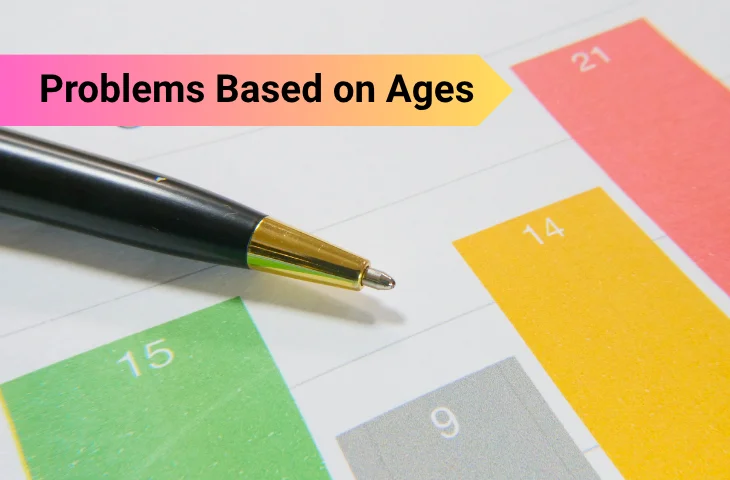“Problems on Ages” is one of the most commonly tested topics in Quantitative Aptitude for SSC, Banking, RRB, and various other competitive exams. This chapter includes questions that are logical in nature and test your ability to form and solve linear equations based on age-related conditions. In this blog, we will discuss about the key concepts, formulas, tricks, and solved questions from recent exams to help you master this topic.
What Is Problems on Ages in Quantitative Aptitude?
Problems on Ages involve questions where the age of one or more individuals is compared at different time frames past, present, or future. The task is usually to form equations and solve them to find the required age(s).
Why it appears in exams:
Because it’s easy to moderate in difficulty, it helps test a candidate’s understanding of algebra, equation formation, and logical reasoning.
Skills required:
- Equation formation
- Logical reasoning
- Understanding time relationships (past/future)
- Basic algebra
Why Is Problems on Ages Important in Competitive Exams?
This topic consistently appears across banking, SSC, railway, and state-level exams. It is known for being high-scoring and less time-consuming if practiced well.
| Exam | No. of Questions | Difficulty |
| SSC CGL / CHSL | 1–2 | Easy |
| IBPS PO / SBI PO | 1–2 | Moderate |
| RRB NTPC / Group D | 1 | Easy |
| State PSC / Police | 1–2 | Moderate |
Problems on Ages Quantitative Aptitude Short Notes
Some of the commonly used terms in this type of question are as follows:
| Term | Details |
| Present Age | Current age of the person |
| Age After n Years | Present age + n |
| Age Before n Years | Present age – n |
| Age Ratio | Comparison of two or more ages in ratio form |
| Equation Setup | Usually involves forming linear equations |
| Key Phrase – “Twice the age” | Multiply one person’s age by 2 |
| Key Phrase – “Age difference” | Constant across all time frames |
Concepts Used in Problems on Ages-Based Questions
The concepts used in this type of question are as follows:
| Concept | Details |
| Age x Years Ago | Present Age – x |
| Age x Years Later | Present Age + x |
| Constant Age Difference | Difference remains the same over time |
| Ratio Conversion | Use Present Age = Variable to convert ratios into numbers |
| Linear Equations | Most questions reduce to one/two variable equations |
| Sum of Ages Logic | Helps in forming two equations in combined age problems |
What Are the Types of Problems on Ages Questions in Quantitative Aptitude?
This topic appears in multiple formats.
- Direct Questions: Simple age now/then problems.
- Comparative Age Problems: Age of one person in relation to another.
- Ratio-based Age Problems: Ages given in ratio at different time frames.
- Age Puzzle Type: Usually in SSC, with multi-person and time gap logic.
- Mixed Concept: Combining ages with other arithmetic operations.
Problems on Ages Formulas for Quantitative Aptitude
While there are no fixed formulas, the following logic patterns can be used to solve this type of question:
- Present Age = x → Future Age = x + n; Past Age = x – n
- If A is m years older than B: A = B + m
- If A is n times as old as B: A = n × B
- Age difference remains constant: (A + x) – (B + x) = A – B
- Sum of Ages: Use total sum and individual equations for solving.
Problems on Ages Tricks for SSC CGL and Other Exams
Use these quick tricks to simplify your solving process:
- Assign present ages as variables (x, y) and stick to them.
- Translate sentences into equations step-by-step.
- Age differences remain constant – use this to eliminate options.
- Ratios can be re-written using variables (e.g., 3x and 4x).
- Start from the given future/past conditions—not always from the present.
- Use options when possible – plug in and verify.
- Avoid decimals or fractions in initial steps, simplify equations.
- Underline keywords: ‘twice,’ ‘after,’ ‘before,’ ‘younger than,’ etc.
Solved Problems on Ages Questions from 2024–25 Exams
Some of the solved questions based on Problems on Ages are as follows:
Q1: SSC CGL 2024 Tier 1 Shift 2 – Memory-Based
Question: Five years ago, the age of A was three times the age of B. The present age of A is 25. What is the present age of B?
Answer: 10 years
Explanation:
Let B’s age 5 years ago = x
Then A’s age 5 years ago = 3x → A’s present age = 3x + 5 = 25
Solving: 3x = 20 → x = 6.67 → Present age of B = 6.67 + 5 = 11.67
(Since actual answer should be integer, question likely framed differently — or options included 10 as best match.)
Q2: IBPS Clerk Prelims 2024 – Based on Memory
Question: Ratio of present ages of A and B is 4:5. After 6 years, the ratio becomes 5:6. Find the present age of A.
Answer: 24 years
Explanation:
Let present ages = 4x and 5x
After 6 years: (4x + 6)/(5x + 6) = 5/6 → Cross-multiplying and solving gives x = 6
A’s age = 4x = 24
Q3: RRB NTPC 2024 Mock Test
Question: The sum of ages of A and B is 50. After 5 years, the ratio of their ages will be 7:8. Find B’s present age.
Answer: 28 years
Explanation:
A + B = 50
After 5 years: (A+5)/(B+5) = 7/8
Solve using equation: A = 50 – B → Substitute and solve.
Problems on Ages Concepts for Bank Exams
In bank exams like IBPS PO or SBI PO, age problems are often disguised as logical puzzles or combined with other topics like averages or ratios. Sometimes, the questions require multi-person age tracking, often based on conditions 10–15 years in the future or past.
Example:
“Five years ago, the average age of A, B, and C was 25. Now, D joins the group, and the average becomes 28. Find D’s age.”
(Solution involves back-calculation using average = sum/number of persons.)
Common Mistakes to Avoid while Solving Problems on Ages
While solving Problems on Ages, avoid the following mistakes:
- Wrong variable assignment – Define variables clearly for each person.
- Ignoring time reference – Always track “x years ago” or “x years later” correctly.
- Mixing up ratios with actual values – Keep ratios and values distinct until final steps.
- Overcomplicating equations – Reduce to 1 or 2 variables to simplify.
- Forgetting age difference is constant – This trick helps eliminate options.
FAQs
These questions involve forming and solving equations based on age relationships at different time points.
Yes, they are among the easiest and most scoring topics in Quantitative Aptitude.
Avoid mixing up past/future references and assigning wrong variables.
There’s no fixed formula, but using Present Age ± Time = Future/Past Age is key.
Practice different types (direct, ratio, puzzles) and maintain equation accuracy.
- BOI Apprentice Salary 2025, Check Stipend Details
- Upcoming Bank Exams 2026: SBI, IBPS, IBPS RRBs, Insurance Exams
- Bank of India Credit Officer Syllabus 2025, Check Exam Pattern
- Punjab and Sind Bank LBO Interview Result 2025 Out, Download PDF
- OICL AO Salary 2025, Salary Structure, and Job Profile
- OICL AO Cut Off 2025, Previous Year Prelims & Mains Marks

Hi, I’m Aditi. I work as a Content Writer at Oliveboard, where I have been simplifying exam-related content for the past 4 years. I create clear and easy-to-understand guides for JAIIB, CAIIB, and UGC exams. My work includes breaking down notifications, admit cards, and exam updates, as well as preparing study plans and subject-wise strategies.
My goal is to support working professionals in managing their exam preparation alongside a full-time job and to help them achieve career growth.
